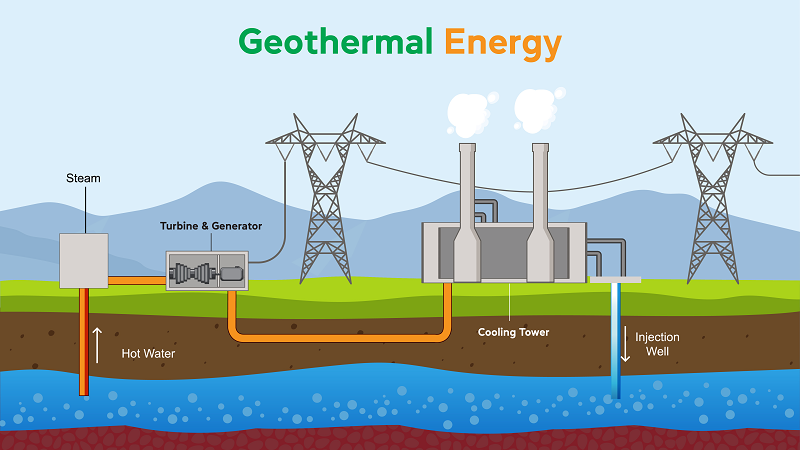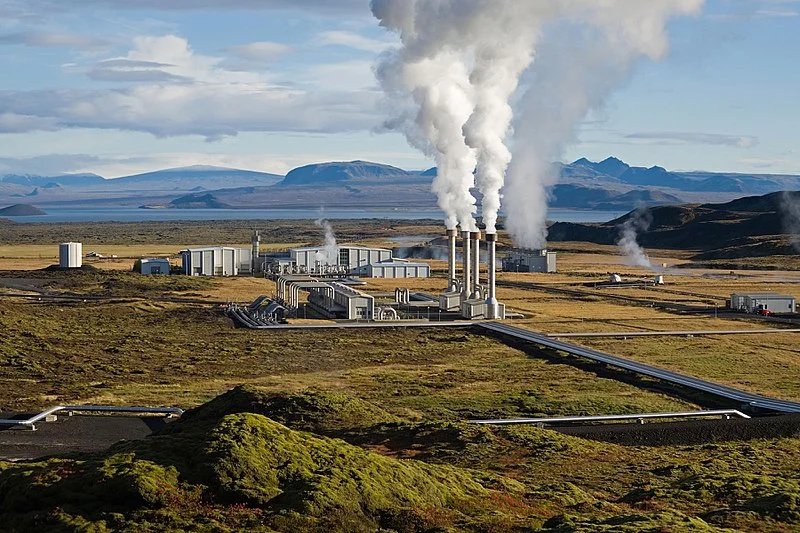Geothermal energy is a clean, renewable power source that takes advantage of heat within the Earth’s crust to generate electricity.
Geothermal energy has significant environmental benefits compared to fossil fuel power plants.
This article explores the pros and cons to evaluate if geothermal power is truly an eco-friendly energy source.
Is Geothermal Energy Good for the Environment?
Yes, geothermal energy is decisively good for the environment compared to conventional fossil fuel power plants.
Geothermal leverages natural heat to generate electricity with minimal emissions, land use, and ecosystem disruption.
It provides renewable baseload power to supplement wind and solar.
While geothermal has limitations, its environmental benefits far outweigh the costs.
When available, geothermal energy is a clean, green way to produce electricity.
Key Points
- Geothermal plants emit minimal greenhouse gases and air pollutants like sulfur dioxide. This gives geothermal an environmental edge over fossil fuels.
- Geothermal requires far less land area than coal, natural gas, solar, or wind plants per unit of electricity generated.
- Geothermal sustains constant baseload power unaffected by weather variability, unlike wind and solar generation.
How Does Geothermal Energy Work?
Geothermal power plants generate electricity by tapping into pockets of heat beneath the Earth’s surface, known as geothermal reservoirs.
There are three types of geothermal plants:
- Dry steam plants use steam from reservoirs directly to turn turbine generators.
- Flash plants pull deep, high-pressure hot water into lower-pressure tanks to create steam for turbines.
- Binary cycle plants transfer heat from geothermal fluids to a secondary fluid to generate power.
While geothermal sites are limited by geographical location, advances in drilling technology enable access to untapped resources.
The United States leads global geothermal power generation, but growth potential exists across the Americas, Asia, and Europe.
Is Geothermal Energy Renewable?
Geothermal energy is considered a renewable power source, although heat mining does deplete underground reservoirs over time.
With proper management, geothermal fields can be sustained for long periods.
Enhanced geothermal systems (EGS) inject fluid to replenish geothermal capacity, increasing reservoir longevity.
While not infinite, preserved geothermal reservoirs can offer renewable base load power for decades with minimal environmental disruption.
How Does Geothermal Compare to Other Renewable Energy Sources?
To assess geothermal’s eco-friendliness, it is useful to compare its sustainability metrics against other clean energy alternatives:
Solar PV
- Geothermal requires no fuel and emits minimal greenhouse gases, giving it an edge over solar.
- Solar photovoltaic needs more land area than geothermal for equivalent energy output.
- Solar produces no emissions while operating but has higher life-cycle emissions from manufacturing.
Wind
- Geothermal produces constant reliable power compared to wind’s variability.
- Wind turbines need large land areas and can disrupt natural landscapes. Geothermal has smaller spatial needs.
- Life-cycle emissions are similar, but geothermal does not rely on the weather and delivers steady baseload power.
Hydropower
- Both offer low-carbon renewable power. But geothermal does not impact aquatic ecosystems like dams.
- Hydropower reliability depends on precipitation and water flows. Geothermal maintains constant output.
- Hydropower dams radically transform landscapes. Geothermal plants have minimal visibility.
Biomass
- Carbon-neutral biomass outperforms geothermal in emissions. But biomass requires extensive land use changes.
- Biomass depends on combustion. Geothermal leverages natural heat for zero-emissions generation.
- While renewable, biomass resources are finite. Geothermal sustainably extracts Earth’s natural heat.
Does Geothermal Energy Help Fight Global Warming?
Geothermal power substantially reduces greenhouse gas emissions from electricity generation.
The mix of renewables needed to stabilize the climate will require a portfolio of low-carbon energy sources with different production profiles.
Geothermal offers sizeable emission reductions compared to fossil fuels while delivering reliable always-on power production with a small environmental footprint.
In the right locations, geothermal energy is a sustainable way to provide electricity and mitigate greenhouse gas emissions.
Is Geothermal Energy Environmentally Friendly?
Yes, geothermal is one of the most eco-friendly utility-scale energy sources available today.
It leverages a renewable heat resource that emits minimal greenhouse gases, uses little water, and has a small operational footprint.
Geothermal plants release negligible air pollutants and do not damage ecosystems or natural landscapes like dams or wind farms sometimes do.
The life-cycle emissions from geothermal power generation are far below those of fossil fuel plants.
While not perfect, geothermal has decisively positive sustainability attributes compared to coal, gas, oil, or even other renewables like solar and wind.
Where sufficient geothermal resources exist, geothermal power plants provide clean, green electricity crucial to fighting climate change.
What Are the Negative Effects of Geothermal Energy on the Environment?
While geothermal is clean and renewable overall, it does have some potential drawbacks:
- Fluid injection into reservoirs has induced seismic events in certain locations when not carefully monitored.
- Cooling towers consume water resources, though less than fossil fuel plants.
- Heat extraction can cause land subsidence in surrounding areas.
- Power plants release traces of sulfur dioxide and silica emissions.
- Steam collection produces noise pollution near sites.
- Constructing roads and pipelines can disturb undeveloped land.
- Gases like hydrogen sulfide are inherent to geothermal processes.
- Limited suitable subsurface locations restrict widespread adoption. Most negative impacts are minor and can be mitigated with proper site selection and reservoir management.
Is Geothermal Energy Bad for Global Warming?
No, geothermal energy is beneficial, not detrimental, in the fight against global warming and climate change.
Geothermal plants emit negligible greenhouse gases when generating electricity.
The emissions per kWh are minuscule compared to burning coal, oil, or natural gas.
Geothermal power displaces fossil fuel plants, directly avoiding large amounts of carbon dioxide output.
It provides constant renewable electricity to supplement variable wind and solar generation.
Geothermal energy is decisively not bad for global warming – it is a critical zero-emission technology that helps mitigate greenhouse gas emissions within the power sector as nations work to decarbonize their economies.
More geothermal capacity is a positive for reducing global carbon levels over the coming decades.
Conclusion: The Benefits Outweigh the Costs
Geothermal energy is one of the most environmentally friendly utility-scale energy sources available today.
While no power generation comes without tradeoffs, geothermal provides renewable baseload electricity, operates sustainably within the limits of natural heat flows, and minimizes impacts on ecosystems and wildlife.
Compared to coal and natural gas, geothermal delivers tremendous carbon reductions essential to curbing climate change.
Overall, geothermal energy is decisively good for the environment and will play an expanding role in building a distributed clean energy economy.
The pros of minimal air emissions, land use efficiency, grid reliability, and climate change mitigation outweigh geothermal power’s limited cons.
While geographical constraints exist, geothermal energy is an eco-friendly electricity option we should utilize wherever viable resources allow.
FAQ
How does geothermal energy reduce global warming?
Geothermal plants do not burn fuels, so they release negligible amounts of greenhouse gases like carbon dioxide during operation. This gives geothermal power generation an extremely low carbon footprint compared to coal and natural gas electricity. Implementing geothermal energy helps nations reduce emissions and mitigate climate change.
Is geothermal energy sustainable?
With proper reservoir management, geothermal fields can provide renewable baseload power for many decades. Techniques like fluid injection help replenish geothermal capacity over time. While not infinite, preserved reservoirs offer sustainable deep Earth heat extraction with minimal ecosystem disruption.
Can geothermal energy replace fossil fuels?
Geothermal alone cannot replace all fossil fuel electricity generation due to limited suitable subsurface locations. However, geothermal is an important zero-emission renewable source and should be deployed extensively where viable. Combined with wind, solar, hydropower, and other renewables, geothermal can help nations transition away from coal and gas-fired plants.
How does geothermal energy help the environment?
Geothermal assists the environment in four key ways: 1) It produces copious carbon-free electricity; 2) It uses minimal water compared to other plants; 3) It requires very little land area for energy output; 4) It delivers renewable baseload power to complement variable wind and solar generation.
The team at GreenChiCafe is passionate about renewable energy and sustainability. Geothermal power is one of the most eco-friendly utility-scale electricity sources available today. Be sure to check out GreenChiCafe.com for more content on clean energy and our natural world.

Annie is a passionate environmental writer and activist. She has been writing about sustainability, conservation, and green living for over 15+ years. Annie is dedicated to raising awareness about environmental issues and providing practical tips for living an eco-friendly lifestyle. When she’s not writing, you can find her volunteering with local environmental organizations, teaching workshops on zero waste living, or exploring nature. Feel free to get in touch with Annie: annie@greenchicafe.com


